Prismatic glass offers enhanced light diffusion and clarity, making it ideal for partitions requiring privacy without sacrificing natural light. Patterned glass provides decorative texture and obscured visibility, suited for partitions emphasizing aesthetics and moderate privacy.
Table of Comparison
| Feature | Prismatic Glass | Patterned Glass |
|---|---|---|
| Light Control | Diffuses natural light with minimal glare | Obscures view while allowing moderate light transmission |
| Privacy Level | Moderate privacy; distorts image behind glass | High privacy; patterns block clear visibility |
| Design Style | Modern, sleek linear patterns | Varied textures and motifs for decorative appeal |
| Durability | High; resistant to scratches and impact | Moderate; decorative surface may wear over time |
| Maintenance | Easy to clean with standard glass cleaners | Requires careful cleaning to preserve patterns |
| Cost | Higher due to specialized manufacturing | Generally lower; mass-produced patterns |
| Applications | Office partitions, privacy screens with light optimization | Decorative partitions, privacy in residential and commercial spaces |
Introduction to Glass Partitions
Prismatic glass and patterned glass both offer unique benefits for glass partitions, enhancing privacy and aesthetic appeal. Prismatic glass refracts light to create vibrant visual effects while maintaining translucency, ideal for dynamic office environments. Patterned glass provides textured surfaces that obscure visibility, ensuring privacy without sacrificing natural light flow.
What is Prismatic Glass?
Prismatic glass is engineered with micro-prismatic structures that manipulate light to enhance brightness and reduce glare, making it ideal for partitions in office or commercial spaces where natural light diffusion is essential. Unlike patterned glass, which features embossed or etched designs primarily for decorative and privacy purposes, prismatic glass focuses on optical performance by redirecting and diffusing light more efficiently. This advanced light control property makes prismatic glass a superior choice for partitions that require both visual comfort and functional aesthetics.
What is Patterned Glass?
Patterned glass features textured surfaces created through rolling or embedding designs during manufacturing, providing enhanced privacy and decorative appeal for partitions. It diffuses light while obscuring visibility, making it ideal for office or bathroom partitions where both light transmission and confidentiality are needed. Unlike prismatic glass, which refracts light to improve glare control and brightness, patterned glass primarily offers aesthetic texture and privacy without significant light bending.
Aesthetic Differences Between Prismatic and Patterned Glass
Prismatic glass enhances interiors by refracting light into vibrant rainbows, creating dynamic visual effects and a shimmering, multidimensional appearance that elevates modern partition designs. Patterned glass, featuring embossed or etched textures, offers a more subtle aesthetic with decorative motifs that provide privacy while adding depth and character through tactile visual interest. The choice between prismatic and patterned glass influences the partition's ambiance--prismatic glass emphasizes light interplay and color, whereas patterned glass emphasizes texture and decorative detail.
Light Diffusion and Privacy Comparison
Prismatic glass offers superior light diffusion by refracting light through its textured surface, creating bright, evenly distributed illumination while maintaining partial visibility and moderate privacy. Patterned glass enhances privacy with intricate designs that obscure direct views, but it diffuses light less effectively, resulting in softer, less uniform brightness. For partitions, prismatic glass balances light transmission and moderate privacy, whereas patterned glass prioritizes privacy at the expense of optimal light diffusion.
Strength and Durability Considerations
Prismatic glass offers enhanced strength due to its specialized surface texture that disperses impact forces, making it more resistant to cracks and chips compared to patterned glass. Patterned glass provides moderate durability with decorative embossments that can slightly weaken structural integrity under high stress. For partitions requiring long-lasting performance, prismatic glass is the superior choice, especially in high-traffic or industrial environments.
Installation and Maintenance Aspects
Prismatic glass offers superior light diffusion and requires precise installation to align its optical patterns accurately, ensuring optimal light distribution; maintenance involves regular cleaning with non-abrasive agents to preserve clarity without scratching its surface. Patterned glass, characterized by textured designs, allows easier installation due to its uniform thickness but demands careful sealing to prevent dirt accumulation in grooves, necessitating frequent cleaning with soft brushes or cloths. Both types benefit from professional handling during installation to maintain structural integrity, while periodic maintenance extends their aesthetic and functional lifespan in partition applications.
Cost Comparison: Prismatic vs Patterned Glass
Prismatic glass typically incurs higher costs than patterned glass due to its complex manufacturing process that enhances light diffusion and energy efficiency in partitions. Patterned glass offers a more budget-friendly option while still providing privacy and decorative appeal with embossed or textured designs. Choosing between prismatic and patterned glass often depends on balancing initial investment against long-term performance benefits and aesthetic preferences.
Popular Applications for Each Glass Type
Prismatic glass is commonly used in office partitions and interior room dividers to enhance privacy while allowing natural light diffusion, making it ideal for modern workspaces and healthcare facilities. Patterned glass is frequently applied in residential partitions, shower enclosures, and decorative wall panels, offering both aesthetic appeal and obscured visibility. Each glass type caters to distinct needs: prismatic glass excels in light management and privacy in professional environments, while patterned glass emphasizes design and texture in living spaces.
Choosing the Right Glass for Your Partition
Prismatic glass enhances privacy while maximizing natural light diffusion, making it ideal for office partitions where illumination and discretion are essential. Patterned glass offers varied textures and designs that add aesthetic appeal and hide imperfections, suitable for decorative partitions in both commercial and residential spaces. Selecting the right glass depends on balancing light transmission, privacy needs, and visual style to complement the partition's functional and design requirements.

Infographic: Prismatic glass vs Patterned glass for Partition
 azmater.com
azmater.com